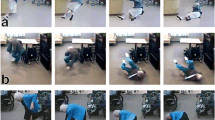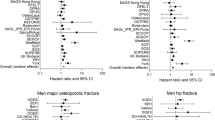Abstract
Bones break because the forces applied to them exceed their strength. For most non-spine fractures, this force results from a fall. Falls generate at least 10 times the energy necessary to fracture the proximal femur, but only 5%–10% of falls in older white women cause fractures and only 1% cause hip fractures. The mechanics of the fall plays a very important role in whether a fracture will occur and which bone will fracture. This review postulates that orientation of the fall and location of the impact determine the type of fracture, and whether a fracture occurs depends on the energy of the fall (distance to impact and weight of the moving parts) and how much of that energy is absorbed by protective responses, the impact surface and soft tissues over the bone. Recent case-control studies support the view that the mechanics of a fall are the most important determinant of whether it will result in a hip fracture.
Similar content being viewed by others
References
Nevitt MC, Cummings SR. Falls and fractures in older women. In: Vellas B, Toupet M, Rubenstein L, Albarede JL, Christen Y, editors. Falls, balance and gait disorders in the elderly. Paris: Elsevier, 1992:69–80.
Tinetti ME, Williams TF, Mayewski R. Fall risk index for elderly patients based on number of chronic disabilities. Am J Med 1986;80:429–34.
Nevitt MC, Cummings SR, Kidd S, Black D. Risk factors for recurrent nonsyncopal falls. JAMA 1989;261:2663–8.
Cummings SR, Nevitt MC. A hypothesis: the causes of hip fractures. J Gerontol Med Sci 1989;44:M107–11.
Nevitt MC, Cummings SR. Type of fall and risk of hip and wrist fractures: the study of osteoporotic fractures. J Am Geriatr Soc 1993.
Hayes WC, Myers ER, Morris JN, Gerhart TN, Yett HS, Lipsitz LA. Impact near the hip dominates fracture risk in elderly nursing home residents who fall. Calcif Tissue Int 1993;52:192–8.
Hayes WC, Piazza SJ, Zysset PK. Biomechanics of fracture risk prediction of the hip and spine by quantitative computed tomography. Radiol Clin North Am 1991;29:1–18.
Meyer HE, Tverdal A, Falch JA. Risk factors for hip fracture in middle-aged Norwegian women and men. Am J Epidemiol 1993:137:1203–11.
Faulkner KG, Cummings SR, Black D, Palermo L, Glüer C-C, Genant HK. Simple measurement of femoral geometry predicts hip fracture: the study of osteoporotic fractures. J Bone Miner Res 1993;10:1211–7.
Lauritzen JB, Petersen MM, Lund B. Effect of external hip protectors on hip fractures. Lancet 1993;341:11–3.
Robinovitch SN, Hayes WC, McMahon TA. Prediction of femoral impact forces in falls on the hip. ASME J Biomech Eng 1991;113:366–74.
Melton LJI, Chao EYS, Lane J. Biomechanical aspects of fractures. In: Riggs BL, Melton LJI, editors. Osteoporosis: etiology, diagnosis and management. New York: Raven Press, 1988:111–31.
Author information
Authors and Affiliations
Consortia
Rights and permissions
About this article
Cite this article
Cummings, S.R., Nevitt, M.C. & the Study of Osteoporotic Fractures Research Group. Non-skeletal determinants of fractures: the potential importance of the mechanics of falls. Osteoporosis Int 4 (Suppl 1), S67–S70 (1994). https://doi.org/10.1007/BF01623439
Issue Date:
DOI: https://doi.org/10.1007/BF01623439




